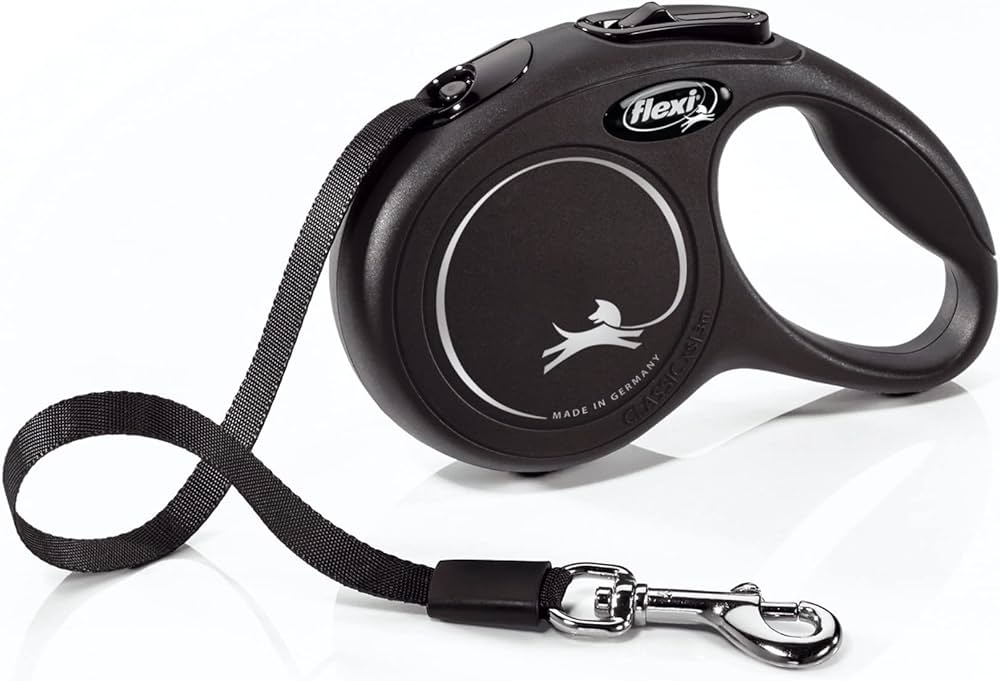Why Dog Trainers Warn Against Retractable Leashes: 2024 Safety & Training Concerns
Have you ever wondered why dog trainers seem to cringe at the sight of retractable leashes? Even though their popularity among pet owners, these seemingly convenient devices have become a source of contention in the…
Have you ever wondered why dog trainers seem to cringe at the sight of retractable leashes? Even though their popularity among pet owners, these seemingly convenient devices have become a source of contention in the dog training community.
We’ll explore the reasons behind trainers’ aversion to retractable leashes and why they’re often banned from training classes. From safety concerns to behavior issues, we’ll unpack the drawbacks that make these leashes a less-than-ideal choice for many dog professionals. By the end of this article, you’ll understand why trainers prefer alternative options and how to make the best choice for your furry friend’s safety and training progress.
Understanding Retractable Leashes
Retractable leashes are popular among dog owners but often discouraged by trainers. These leashes consist of a thin cord wound around a spring-loaded device inside a plastic handle. Let’s explore how they work and the different types available.
How They Work
Retractable leashes feature a cord that extends and retracts from a plastic handle. The handle houses a spring-loaded mechanism controlled by a button. When the button is released, the cord locks in place. Pressing the button allows the cord to extend or retract, giving dogs more freedom to roam.
The cord length varies, typically ranging from 10 to 26 feet. This design allows dogs to explore their surroundings while still being connected to their owners. But, the increased distance can make it challenging for owners to maintain control over their pets, especially in busy or potentially dangerous environments.
Types of Retractable Leashes
Several types of retractable leashes are available, designed for different dog sizes and owner preferences:
- Standard retractable leashes: These are the most common, suitable for small to medium-sized dogs.
- Heavy-duty retractable leashes: Designed for larger breeds, these feature stronger cords and mechanisms.
- Tape-style retractable leashes: Instead of a thin cord, these use a flat tape, reducing the risk of cuts or burns.
- Multi-dog retractable leashes: These allow owners to walk multiple dogs simultaneously, with separate cords for each dog.
- Retractable leashes with built-in accessories: Some models include features like LED lights, waste bag dispensers, or treat compartments.
While these variations offer different features, they all share the same basic mechanism and potential drawbacks that concern dog trainers.
Safety Concerns for Dogs and Owners
Retractable leashes pose important safety risks for both dogs and their owners. These issues stem from the design and functionality of these leashes, which can lead to various hazardous situations.
Potential for Neck Injuries
Retractable leashes can cause severe neck injuries to dogs. The sudden jerking motion when a dog reaches the end of the leash puts extreme stress on their neck, potentially causing:
- Damage to the trachea
- Spinal cord injuries
- Whiplash
- Aggravation of existing neck problems
This risk is heightened when retractable leashes are used with choke chains, prong collars, or pinch collars. The constant pressure can desensitize dogs to leash tension, leading to more forceful pulling and increased injury risk.
Lack of Control in Emergencies
Retractable leashes significantly reduce an owner’s control over their dog, especially in emergency situations. This lack of control manifests in several ways:
- Difficulty reeling in the dog quickly when needed
- Limited ability to guide the dog away from potential dangers
- Increased reaction time to unexpected events
- Reduced effectiveness of verbal commands due to distance
In busy areas or near traffic, this lack of control can put dogs at risk of accidents or confrontations with other animals. It’s crucial for owners to maintain close control of their dogs in unpredictable environments.
Risk of Leash Breakage
Retractable leashes are more prone to breakage compared to standard leashes, presenting additional safety hazards:
- Thin cords can snap under sudden pressure
- Mechanical failures in the retraction mechanism
- Wear and tear from frequent use
- Increased risk of malfunction in extreme weather conditions
A broken leash can result in a dog running loose, potentially leading to accidents, lost pets, or dangerous situations for both the dog and others in the vicinity.
Dangers to Humans
Retractable leashes don’t just pose risks to dogs; they can be dangerous for humans as well:
- Rope burns from the cord wrapping around limbs
- Cuts or lacerations from the thin, fast-moving cord
- Falls caused by entanglement in the leash
- Injuries from the handle being yanked out of hand
These injuries can be particularly severe if the cord wraps around fingers or other body parts as the dog pulls away. In some cases, these incidents have led to amputations or important tissue damage.
Impact on Dog Training
Retractable leashes significantly hinder effective dog training by reinforcing undesirable behaviors and undermining consistent guidance. These leashes present multiple challenges that can impede a dog’s progress in learning proper walking etiquette and obedience.
Encouraging Pulling Behavior
Retractable leashes inadvertently reward pulling, making loose-leash walking difficult to achieve. The constant tension on these leashes teaches dogs that pulling is necessary to move forward. This continuous pressure desensitizes dogs to leash tension, leading them to pull more persistently. As a result, dogs learn to ignore gentle leash cues and struggle to walk calmly beside their owners. The variable length of retractable leashes further confuses dogs about appropriate walking distances, reinforcing the idea that pulling grants more freedom to explore.
Hindering Leash Manners
The inconsistent nature of retractable leashes makes it challenging for dogs to develop good leash manners. Dogs struggle to understand the concept of walking close to their owners due to the variable leash length. This confusion often persists even when switched to a regular leash, as dogs have learned to expect varying distances. The lack of clear boundaries makes it difficult for dogs to grasp proper leash etiquette, such as walking politely in heel position or responding to leash pressure cues. So, dogs may continue to pull, lunge, or wander, regardless of the leash type used.

Promoting Wandering Tendencies
Retractable leashes encourage dogs to wander and explore without guidance, undermining training efforts. The extended reach allows dogs to roam far from their owners, making it challenging to maintain control and focus during walks. This freedom often leads to increased distractions and decreased responsiveness to commands. Dogs may become overly fixated on environmental stimuli, ignoring their owners’ cues and making it difficult to redirect their attention. The inconsistent proximity to the handler can also hinder the development of a strong bond and reliable recall, essential components of effective dog training.
Practical Drawbacks
Dog trainers often criticize retractable leashes due to several important drawbacks. These issues range from safety concerns to training difficulties, making them less than ideal for responsible dog ownership.
Safety Risks
Retractable leashes pose serious safety hazards for both dogs and their owners. Dogs can suffer neck and throat injuries from the sudden jolt when reaching the end of the leash, potentially exacerbating existing conditions like pinched discs. The long cord can cause burns, cuts, and entanglements, with the risk of severe injury to handlers, including finger amputation if the leash wraps around digits.
Difficulty in Training
Training dogs becomes considerably more challenging with retractable leashes. They hinder the development of loose-leash walking skills by teaching dogs to pull constantly. The constant tension on the leash reinforces the idea that pulling is necessary to move forward, contradicting the goal of walking with slack in the leash. This behavior can persist even when switching to a regular leash, making consistent training more difficult.
Pairing Issues With Other Equipment
Retractable leashes often conflict with other essential dog training equipment. They’re incompatible with head halters and front-clip harnesses, tools frequently recommended by trainers for better control. The inconsistent tension of retractable leashes can render these tools ineffective or even dangerous. Also, the thin cords of retractable leashes may tangle with or damage other equipment, potentially compromising their integrity and effectiveness during crucial training sessions.
Awkward Handling and Weight
The design of retractable leashes presents handling challenges for dog owners. The bulky plastic housing adds important weight, making it uncomfortable to hold for extended periods. This awkwardness can lead to fatigue and reduced control, especially during longer walks. The mechanism’s complexity also makes quick reactions difficult in emergencies, as locking or releasing the leash requires manipulating small buttons. This delay in response time can be critical in potentially dangerous situations, further highlighting the practical drawbacks of retractable leashes in everyday use.
Situations Where Retractable Leashes May Be Appropriate
While dog trainers generally advise against retractable leashes, there are exact situations where they might be suitable. We’ll explore these scenarios, keeping in mind that safety and control should always be the top priorities.
Controlled Environments
Retractable leashes can be appropriate in controlled environments with minimal distractions. Open fields, empty beaches, or quiet trails offer spaces where dogs can explore safely. These areas have a low likelihood of encountering other people, dogs, or potential hazards. But, it’s crucial to remain vigilant and ready to lock the leash if needed. Elderly dogs in their own yards might benefit from the extra freedom a retractable leash provides, allowing them to move at their own pace while still under supervision. Always assess the environment for potential risks before using a retractable leash, even in seemingly safe locations.
Exact Dog Types and Sizes
Certain dog types and sizes may be better suited for retractable leashes under exact circumstances. Small, well-behaved dogs in open areas can benefit from the extended range while remaining easily controllable. Dogs with mobility issues or those recovering from injuries might find the adjustable length helpful during rehabilitation walks. But, it’s essential to consider the dog’s temperament, training level, and physical capabilities.
Large or strong dogs are generally not good candidates for retractable leashes due to the increased risk of injury and lack of control. Always use a harness instead of a collar when using a retractable leash to minimize the risk of neck injuries. Remember that regardless of size or type, all dogs require proper training and supervision when using any leash.
Alternatives to Retractable Leashes
Dog trainers recommend several alternatives to retractable leashes that offer better control and safety for both dogs and their owners. These options provide a balance between freedom and security, allowing for effective training and enjoyable walks.
Standard Leash Options
Standard leashes are the go-to choice for most dog trainers. They come in various lengths, typically 4 to 6 feet, and offer consistent control. Flat nylon leashes are durable and affordable, while leather leashes provide a comfortable grip and long-lasting quality. For enhanced visibility during night walks, reflective leashes are an excellent option. Adjustable leashes allow owners to modify the length based on the environment, offering versatility for different situations. Some leashes feature traffic handles near the collar clip, providing extra control in crowded areas. When choosing a standard leash, consider factors such as your dog’s size, strength, and walking habits to ensure the best fit for your needs.
Long-Line Training Tools
Long-line training tools are excellent alternatives for dogs that need more freedom to explore while maintaining control. These leashes typically range from 15 to 50 feet in length, allowing dogs to roam and practice recall in open spaces. Biothane long lines are popular due to their durability and water-resistant properties. Nylon long lines are lightweight and easy to clean.
When using long lines, it’s crucial to pair them with a well-fitted harness to prevent neck injuries. Long lines are particularly useful for recall training, scent work, and giving dogs controlled freedom in safe environments. But, they require careful handling to prevent tangling and are best used in open areas away from traffic and other distractions. Always supervise your dog closely when using a long line and gradually increase the length as your dog’s recall improves.
Conclusion
We’ve explored why dog trainers advise against retractable leashes due to safety concerns and training challenges. While these leashes offer convenience they often hinder proper training and pose risks to both dogs and owners.
We encourage pet owners to prioritize safety and effective training by opting for standard leashes or long lines when appropriate. It’s crucial to assess your dog’s needs and your environment before choosing a leash.
By making informed decisions about leash choices we can ensure safer more enjoyable walks and foster better relationships with our canine companions. Remember the right leash is an investment in your dog’s well-being and training success.

